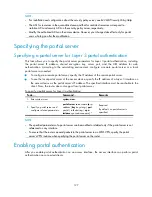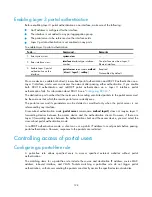
124
Figure 49
Network diagram for portal stateful failover configuration
Router A
Gateway A
Router B
Gateway B
Failover link
Intranet
Host A
Host B
Switch A
Switch B
Stateful failover
interface
Portal enabled
Internet
Server
In a typical portal stateful failover networking environment, as shown in
, users access the
network after passing portal authentication. To avoid portal service interruption caused by single point
failures, configure the stateful failover function on the access devices (Gateway A and Gateway B), so
that the two access devices back up the portal online user information of each other through the failover
link. When one of them (Gateway A or Gateway B) fails, the other can perform portal authentication for
new portal users and guarantee the normal data communication of the online portal users.
Basic concepts
1.
Device states
{
Independence
—A stable running status of a device when it does not establish the failover link
with the other device.
{
Synchronization
—A stable running status of a device when it establishes the failover link with
the other device successfully and is ready for data backup.
2.
User modes
{
Stand-alone
—Indicates that the user data is stored on the local device only. Currently, the local
device is in independence state or it is in synchronization state but has not synchronized the
user data to the peer device yet.
{
Primary
—Indicates that the user logs in from the local device, and the user data is generated
on the local device. The local device is in synchronization state and ready for receiving and
processing packets from the server.
{
Secondary
—Indicates that the user logs in from the peer device, and the user data is
synchronized from the peer device to the local device. The local device is in synchronization
















































